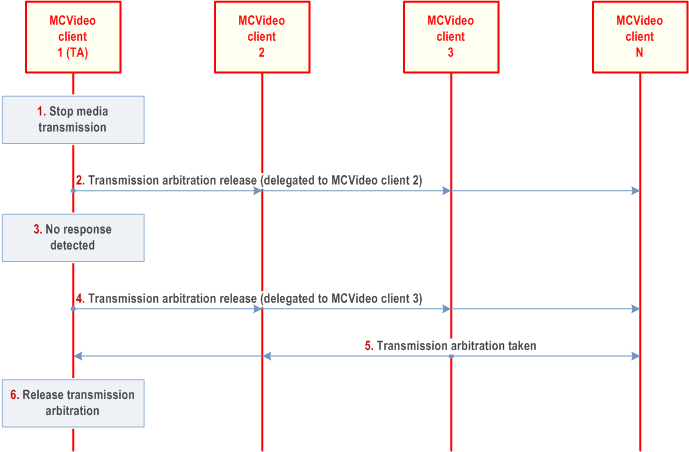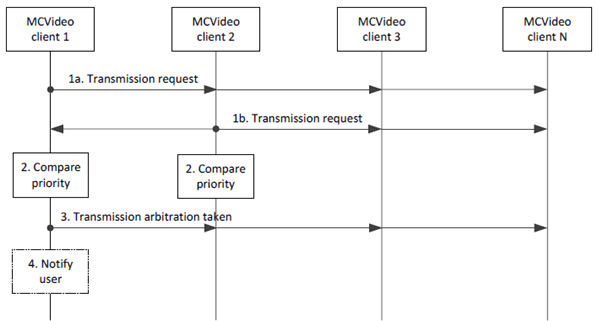Content for TS 23.281 Word version: 19.3.0
1…
5…
6…
7…
7.1.2.3…
7.1.2.3.1.2…
7.1.2.3.2…
7.1.2.4…
7.1.2.5.2…
7.1.3…
7.2…
7.2.2.3…
7.2.2.4…
7.2.3…
7.3…
7.4…
7.4.3…
7.5…
7.5.2.3…
7.6…
7.7…
7.7.1.3…
7.7.1.3.2A…
7.7.1.3.4…
7.7.1.3.6…
7.7.2…
7.7.2.7…
7.7.2.9…
7.8…
7.11…
7.17…
7.19…
7.19.2.8…
7.19.3…
7.19.3.1.4…
7.19.3.2…
7.19.3.2.3…
7.19.3.2.6…
A…
7.7.2.9 Transmission arbitration release
7.7.2.9.1 Transmission arbitration release
7.7.2.9.2 Transmission arbitration release with delegation
7.7.2.10 Simultaneous transmission requests
...
...
7.7.2.9 Transmission arbitration release p. 159
7.7.2.9.1 Transmission arbitration release p. 159
This subclause is applicable only in single arbitrator approach.
Figure 7.7.2.9.1-1 describes procedures for an MCVideo client to release transmission arbitration. There is no other MCVideo client to which transmission arbitration can be delegated.
Pre-conditions:
- An off-network group communication has been established.
- Only MCVideo client 1 is transmitting a video.

7.7.2.9.2 Transmission arbitration release with delegation p. 159
This subclause is applicable only in single arbitrator approach.
Figure 7.7.2.9.2-1 describes procedures for an MCVideo client to release transmission arbitration. There are other MCVideo clients currently transmitting to which transmission arbitration can be delegated.
Pre-conditions:
- An off-network group communication has been established.
- At least one more MCVideo client is transmitting video other than the current transmission arbitrator.

Step 1.
MCVideo client 1 stops video transmission but does not release transmission arbitration.
Step 2.
MCVideo client 1 sends a transmission arbitration release message. The transmission arbitration release message indicates a MCVideo client which is currently transmitting video, MCVideo client 2, as the subsequent transmission arbitrator. The MCVideo client 1 waits for a confirmation before releasing transmission arbitration.
Step 3.
MCVideo client 1 detects no response from MCVideo client 2.
Step 4.
MCVideo client 1 sends another transmission arbitration release message. The transmission arbitration release message indicates another MCVideo client which is currently transmitting video, MCVideo client 3, as the subsequent transmission arbitrator. The MCVideo client 1 waits for a confirmation before releasing transmission arbitration.
Step 5.
MCVideo client 3 sends a transmission arbitration taken message to the MCVideo group.
Step 6.
MCVideo client 1, upon receiving the transmission arbitration taken message releases transmission arbitration.
7.7.2.10 Simultaneous transmission requests p. 160
This subclause is applicable in both the single arbitrator and self arbitration approaches.
Figure 7.7.2.10-1 describes procedures for transmission participants when simultaneous transmission requests are generated when more than one MCVideo client initializes transmission control.
Figure 7.7.2.10-1 shows the expected behaviour if simultaneous transmission requests are generated in the following scenarios:
- a single arbitrator approach is used but there is currently no arbitrator; or
- self arbitration is used.
- An off-network group communication has been established.
- MCVideo client 1 has higher transmission priority than MCVideo client 2.

Step 1a.
The MCVideo client 1 sends the transmission request message to the MCVideo group.
Step 1b.
The MCVideo client 2 sends the transmission request message to the MCVideo group.
Step 2.
On receiving a transmission request message, while waiting for a response to the sent transmission request message, the MCVideo client compares its transmission priority with the transmission priority indicated in the received transmission request message.
Step 3.
On determining that it has higher transmission priority than the received transmission request message(s), and no response to the sent transmission request message is received, the MCVideo client 1 sends the transmission arbitration taken message to the MCVideo group.
Step 4.
MCVideo user may be notified that the video can now be transmitted.